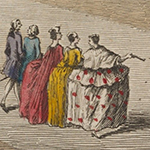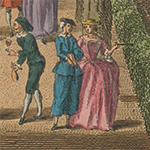Ranelagh Gardens
Names
- Ranelagh Gardens
Street/Area/District
- Ranelagh Gardens
Maps & Views
- 1746 London, Westminster & Southwark (Rocque): Ranelagh Gardens
- 1799 London (Horwood): Ranelagh Gardens
Descriptions
from the Grub Street Project (2006–present)
See also Ranelagh Gardens, by Paul F. Rice.
from London Past and Present: Its History, Associations, and Traditions, by Henry Benjamin Wheatley and Peter Cunningham (1891)
Ranelagh, a place of public entertainment, erected on the site of the gardens of a villa of Earl Ranelagh, at Chelsea, from the designs of William Jones, architect, in 1742. The principal room (the Rotunda) was 150 feet in diameter, with an orchestra in the centre, and tiers of boxes all round. The chief amusement was promenading (as it was called) round and round1 the circular area below, and taking refreshments in the boxes, while the orchestra executed different pieces of music. It was a kind of "Vauxhall under cover," warmed with coal-fires. The rotunda is said to have been projected by Lacy, an actor, and the patentee of Drury Lane Theatre. The coup d'œil, Dr. Johnson declared, "was the finest thing he had ever seen." The last appearance (if one may use the expression) of Ranelagh was when the installation ball of the Knights of the Bath, in 1802, was given there. It was closed after July 8, 1803, and an order made, September 30, 1805, for pulling it down. The site of Ranelagh is now part of Chelsea Hospital garden, between Church Row and the river, to the east of the hospital, the roadway and the barracks. No traces of it remain.
I have been breakfasting this morning at Ranelagh Garden; they have built an immense amphitheatre, with balconies full of little ale houses; it is in rivalry to Vauxhall, and costs above twelve thousand pounds. The building is not finished, but they get great sums by people going to see it and breakfasting in the house: there were yesterday no less than three hundred and eighty persons, at eighteen pence a piece.—Walpole to Mann, April 22, 1742.
The invalides at Chelsea intend to present Ranelagh Gardens as a nuisance, for breaking their first sleep with the sound of fiddles. It opens I think to-night.—Gray to Mr. Chute, vol. ii. p. 187.
Two nights ago Ranelagh Gardens were opened at Chelsea; the prince, princess, duke, much nobility, and much mob besides were there. There is a vast amphitheatre, finely gilt, painted, and illuminated; into which everybody that loves eating, drinking, staring, or crowding is admitted for twelve pence. The building and disposition of the gardens cost sixteen thousand pounds. Twice a week there are to be ridottos at guinea tickets, for which you are to have a supper and music. I was there last night, but did not find the joy of it. Vauxhall is a little better, for the garden is pleasanter, and one goes by water.—Walpole to Mann, May 26, 1742.
Every night constantly I go to Ranelagh; which has totally beat Vauxhall. Nobody goes anywhere else everybody goes there. My Lord Chesterfield is so fond of it that he says he has ordered all his letters to be directed thither.—Walpole to Conway, June 29, 1744.
Walpole has a great many other references to Ranelagh, and notices of it might be multiplied to any extent from other writers. Smollett, speaking from the Matt. Bramble point of view, says, "What are the amusements of Ranelagh? One half of the company are following one another's tails, in an eternal circle, like so many blind asses in an olive mill, where they can neither discourse, distinguish nor be distinguished; while the other half are drinking hot water under the denomination of tea, till nine or ten o'clock at night, to keep them awake for the rest of the evening." On the other hand, the gay young niece was in raptures with everything. The concerts and the company were the permanent attraction, but during several seasons masquerades drew the fashionable world in crowds. Bonnell Thornton's Burlesque Ode on St. Cecilia's Day, set to music by Dr. Burney, was performed with great success at Ranelagh. The usual charge for admission was 2s. 6d., "tea and coffee included." When fireworks were exhibited, the charge was 5s.
There is a good view of the interior of the Rotunda, with the company at breakfast, in the 1754 edition of Stow; and the ground plan of the gardens is carefully laid down in Horwood's Map of London, 1794–1799. Several other views have been published.
1 There is a little poem of Bloomfield's describing this promenading round and round.

